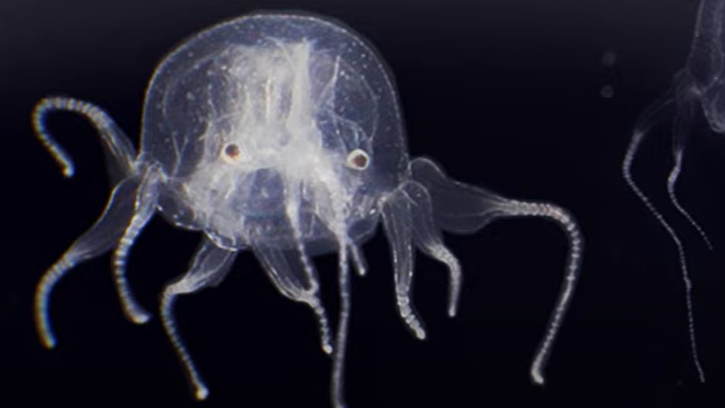
Scientists in Hong Kong have discovered tiny, cube-shaped box jellyfish in a brackish shrimp pond that are completely unknown to science.
The diminutive jellies have a completely transparent and colorless body, or bell, as well as 12 tentacles ending in small, paddle-like structures that enable the critters to speed through water faster than most other jellyfish species.
Like other box jellies — a group of Cnidarians that includes the Australian box jellyfish (Chironex fleckeri), the world’s most venomous marine animal, according to the National Ocean Service — the newly described jellies have 24 eyes arranged in clusters of six around its cubic bell.
"This box jellyfish connects the base of its tentacles and its bell with a flat base that looks like a boat paddle, making it distinct from other common jellyfish," Qiu Jianwen, a professor in the Department of Biology at Hong Kong Baptist University who led the research, said in a video. "Another feature of the box jellyfish is that it has six eyes located on each side of its body."
Researchers named the newfound species Tripedalia maipoensis after Mai Po Nature Reserve in Hong Kong, where they found it. They describe its features and relationship to other box jellies in a study published March 20 in the journal Zoological Studies.
Related: Alien-like giant phantom jellyfish spotted in frigid waters off Antarctica
T. maipoensis is the first-ever box jelly to be found in Chinese waters. It is unclear whether the half-inch-long (1.5 centimeters) animal can sting humans, but it may be venomous enough to stun tiny shrimp called Artemia. "It seemed to paralyze Artemia offered in the lab," Qiu told Live Science in an email. "But we did not touch the animal to feel the sting."
The researchers first noticed the unusual creatures in samples collected from an intertidal shrimp pond, known as a "gei wai" locally, during the summers of 2020 to 2022. The jellyfish were "quite abundant," Qiu told Live Science, numbering "up to 400 individuals in an area of the pond." A tidal channel from the brackish pool means that the species could also be present in the adjacent waters of the Pearl River estuary, but no work has been done yet to confirm this, the researchers wrote in the study.
Box jellyfish, which are also known as sea wasps, move by allowing water to enter canals that run along a muscular membrane on the underside of their bodies and then expelling it. The researchers found that, unlike closely related species, T. maipoensis has forked canals separating into multiple branches. The newly discovered species is the third known member of a group of box jellies characterized by tentacles ending in flat, paddle-like structures, called Tripedalia.
The scientists also noted that each cluster of six eyes on the jellies' cubic bell includes a pair of eyes with lenses that enable image-forming, as well as four eyes that can only sense light.
The species probably feeds on small crustaceans called copepods, which were abundant in the samples taken from the shrimp pond, Qiu told Live Science.
"We are thrilled with this discovery," Qiu said in the video. "Finding a new species in Mai Po, where extensive research has been conducted, highlights the potential for more marine life discovery in the Hong Kong and even the Chinese coastal waters."







